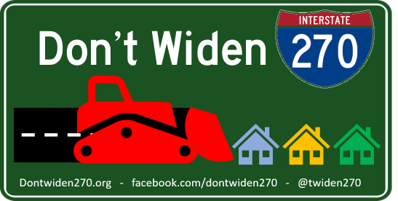A Gift Wrapped in a Warning
The dynamite new editorial from the President of the Northern Virginia Citizens Association shows exactly what we’ll get if MDOT is allowed to duplicate VA’s toll-lane debacle.
“VDOT/Transurban’s I-495 express [toll] lanes opened in 2012 after five long years of construction and a loss of 300 acres of highway tree buffer. We were promised no net cost to taxpayers, reduced congestion, better safety and a predictable commute if we chose to pay a toll.” Sound familiar?
All those promises were broken.
The actual results in VA? “…new choke points where the toll lanes end, longer travel times and increased congestion…” Exactly what expert analysis shows will happen in MD.
“VDOT keeps expanding the express lanes on I-95 to ‘fix’ the problem of congestion caused by merge-area chokepoints.”
“VDOT admits that: 1) The state invested a significant amount of state taxpayer dollars in the project… 2) Drivers were not using the toll lanes as projected; 3) The project actually caused rather than reduced congestion; and 4) Accidents at the merge point are far above the average rate.”
From Maryland Matters (1/14/22): “Use Caution. I-495 Toll Lanes Not as Advertised”
We’ve had many warnings about the dangers of Hogan’s P3, but never one so grounded in lived experience. See below for the Action Item connected to it.
Then read about a closer-to-home warning based on the skyrocketing costs of another P3: the Purple Line. You’ll also find welcome new signs that the toll-lanes are not a done deal, and a quick note about the 2022 gubernatorial race.
ACTION ITEM
Two steps. Read the editorial from the Northern VA Citizens Association. It will take you just three minutes and clarify everything—what Hogan and Transurban are trying to pull off, what their scheme will do to your life, and why we need to stop it now so we can pivot to real transportation solutions.
The goal here is to arm yourself with a clear, simple way to talk about the disastrous P3 project. 2022 is the make-or-break year for the toll lanes, and we’ll increasingly be reaching out to people we know and wavering elected officials. Many of them are stuck in MDOT’s opaque morass of misinformation. They need to hear the real story from well-informed people they trust, like you.
So use this editorial to refine your own retelling of MDOT’s plans. All the supporting evidence of sky-high tolls, increased congestion, worsening safety, and so much more is right here when you need it.
Huge New Costs for Purple Line P3 = Clear Warning for Toll-Lane P3
The Board of Public Works on January 26 will vote on new contracts for the Purple Line P3. Per the Washington Post, “The state’s cost…would climb from $5.6 billion to $9.3 billion” (“Purple Line will open 4½ years late and cost $1.4 billion more to complete, state says”).
The Purple Line P3 was once seen as a model for how governments “could partner with the private sector to build expensive infrastructure…with fewer financial risks.” Now it’s a preview of the enormous financial risks also ahead for the toll-lane P3.
MDOT cites cost increases that it “and the transportation industry as a whole —are facing in the post-pandemic world”, including from rising materials costs, supply chain issues across the construction industry, labor shortages, workforce challenges, and inflation (BPW meeting materials, p. 98).
These factors will surely apply to the toll-lane project as well, leaving taxpayers on the hook for astronomical amounts. Hogan’s promise of toll-lanes at no taxpayer expense? Meaningless.
More Reasons Why the Toll Lane Project is Far from a Done Deal
Our December “vulnerabilities roundup” cited possible delays in MDOT’s mad rush to finalize the project. Sure enough, some key federally mandated milestones have slipped from Spring 2022 to Summer 2022. More delays expected.
With the still unexplained departure of MDOT Secretary Greg Slater, the P3 project lost its most reassuring champion. Slater’s replacement will have a much harder time side-stepping tough questions.
The Maryland National Capital Park and Planning Commission posted its compelling comments on the P3’s Supplemental Draft Environmental Impact Statement. The comments carry real-life consequences if MDOT doesn’t/won’t mitigate the identified harms.
The enormous leap in Purple Line costs described above is sure to bring more scrutiny of the toll-lane P3’s hidden finances.
Snow disaster pics from I-95 in VA clearly showed empty Transurban toll lanes. The promised VA investigation needs to look at the reasons -- whether toll-lane design, agreement with VDOT, sky-high tolls, or other -- why lanes built on the public right-of-way and subsidized by taxpayers were not used in the public interest during that emergency. The answer could create more opposition to MDOT’s plan.
I-95 at Lorton and Newington the afternoon of 1/3/22.
If you see Peter Franchot, please ask him this
Gubernatorial candidate Peter Franchot—the decider who green-lighted Hogan’s toll-lane plan—has been skipping many public forums attended by his fellow candidates.
If you should spot him at a fundraiser (or anywhere, really) please ask him why he, our state’s Comptroller/Chief Financial Officer/Fiscal Watchdog, voted to approve the mega-billion-dollar, 60-year P3 deal without first insisting on an independent financial and legal review.
Is that how he’d govern the state? Let us know what he says.




